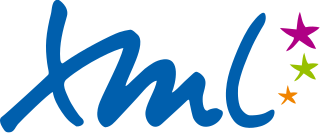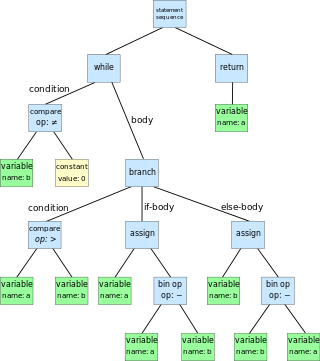In computing, a compiler is a computer program that translates computer code written in one programming language into another language. The name "compiler" is primarily used for programs that translate source code from a high-level programming language to a low-level programming language to create an executable program.
The Common Language Infrastructure (CLI) is an open specification and technical standard originally developed by Microsoft and standardized by ISO/IEC and Ecma International that describes executable code and a runtime environment that allows multiple high-level languages to be used on different computer platforms without being rewritten for specific architectures. This implies it is platform agnostic. The .NET Framework, .NET and Mono are implementations of the CLI. The metadata format is also used to specify the API definitions exposed by the Windows Runtime.
In computer science, the Earley parser is an algorithm for parsing strings that belong to a given context-free language, though it may suffer problems with certain nullable grammars. The algorithm, named after its inventor, Jay Earley, is a chart parser that uses dynamic programming; it is mainly used for parsing in computational linguistics. It was first introduced in his dissertation in 1968.
In computer science, an LALR parser or Look-Ahead, Left-to-right, Rightmost Derivation parser is part of the compiling process where human readable text is converted into computer instructions. An LALR parser is a software tool to process (parse) code into a very specific internal representation that the compiler can work from. This happens according to a set of production rules specified by a formal grammar for a computer language.

Extensible Markup Language (XML) is a markup language and file format for storing, transmitting, and reconstructing arbitrary data. It defines a set of rules for encoding documents in a format that is both human-readable and machine-readable. The World Wide Web Consortium's XML 1.0 Specification of 1998 and several other related specifications—all of them free open standards—define XML.
In computer science, a recursive descent parser is a kind of top-down parser built from a set of mutually recursive procedures where each such procedure implements one of the nonterminals of the grammar. Thus the structure of the resulting program closely mirrors that of the grammar it recognizes.
In computer science, a compiler-compiler or compiler generator is a programming tool that creates a parser, interpreter, or compiler from some form of formal description of a programming language and machine.

In computer science, an abstract syntax tree (AST), or just syntax tree, is a tree representation of the abstract syntactic structure of text written in a formal language. Each node of the tree denotes a construct occurring in the text.
Parsing, syntax analysis, or syntactic analysis is the process of analyzing a string of symbols, either in natural language, computer languages or data structures, conforming to the rules of a formal grammar. The term parsing comes from Latin pars (orationis), meaning part.
Metaprogramming is a programming technique in which computer programs have the ability to treat other programs as their data. It means that a program can be designed to read, generate, analyze or transform other programs, and even modify itself while running. In some cases, this allows programmers to minimize the number of lines of code to express a solution, in turn reducing development time. It also allows programs a greater flexibility to efficiently handle new situations without recompilation.
A domain-specific language (DSL) is a computer language specialized to a particular application domain. This is in contrast to a general-purpose language (GPL), which is broadly applicable across domains. There are a wide variety of DSLs, ranging from widely used languages for common domains, such as HTML for web pages, down to languages used by only one or a few pieces of software, such as MUSH soft code. DSLs can be further subdivided by the kind of language, and include domain-specific markup languages, domain-specific modeling languages, and domain-specific programming languages. Special-purpose computer languages have always existed in the computer age, but the term "domain-specific language" has become more popular due to the rise of domain-specific modeling. Simpler DSLs, particularly ones used by a single application, are sometimes informally called mini-languages.
Extensible Application Markup Language is a declarative XML-based language developed by Microsoft for initializing structured values and objects. It is available under Microsoft's Open Specification Promise.
In computer-based language recognition, ANTLR, or ANother Tool for Language Recognition, is a parser generator that uses a LL(*) algorithm for parsing. ANTLR is the successor to the Purdue Compiler Construction Tool Set (PCCTS), first developed in 1989, and is under active development. Its maintainer is Professor Terence Parr of the University of San Francisco.

JSON is an open standard file format and data interchange format that uses human-readable text to store and transmit data objects consisting of attribute–value pairs and arrays. It is a common data format with diverse uses in electronic data interchange, including that of web applications with servers.

In computer science, the syntax of a computer language is the rules that define the combinations of symbols that are considered to be correctly structured statements or expressions in that language. This applies both to programming languages, where the document represents source code, and to markup languages, where the document represents data.
Grammatical Framework (GF) is a programming language for writing grammars of natural languages. GF is capable of parsing and generating texts in several languages simultaneously while working from a language-independent representation of meaning. Grammars written in GF can be compiled into a platform independent format and then used from different programming languages including C and Java, C#, Python and Haskell. A companion to GF is the GF Resource Grammar Library, a reusable library for dealing with the morphology and syntax of a growing number of natural languages.
Thrift is an interface definition language and binary communication protocol used for defining and creating services for numerous programming languages. It was developed at Facebook for "scalable cross-language services development" and as of 2020 is an open source project in the Apache Software Foundation.

In computing, a compiler is a computer program that transforms source code written in a programming language or computer language, into another computer language. The most common reason for transforming source code is to create an executable program.

Moose is a free and open source platform for software and data analysis built in Pharo.
OMeta is a specialized object-oriented programming language for pattern matching, developed by Alessandro Warth and Ian Piumarta in 2007 under the Viewpoints Research Institute. The language is based on Parsing Expression Grammars (PEGs) rather than Context-Free Grammars with the intent of providing "a natural and convenient way for programmers to implement tokenizers, parsers, visitors, and tree-transformers".





